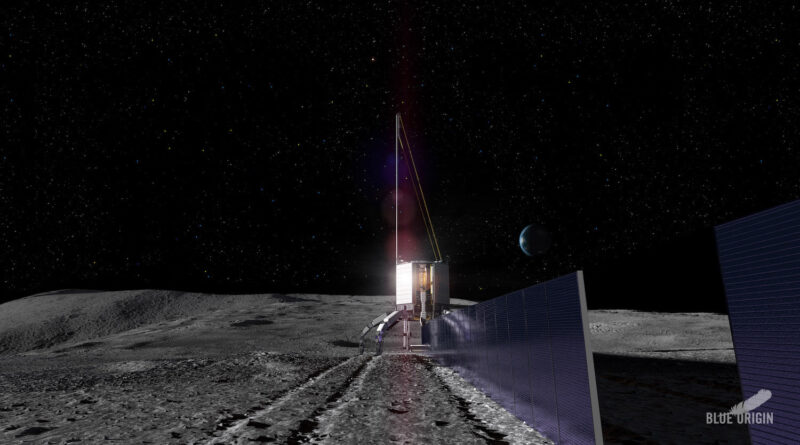NASA Plans To Manufacture Solar Cells On Moon, From Scratch


As if the US solar manufacturing boom is not sparking enough news here on Earth, plans are now in the works to make solar cells on the Moon. That could involve ferrying parts and materials back and forth, but a much more ambitious plan is in the works. NASA has tasked the firm Blue Origin with deploying its Blue Alchemist technology to make solar cells on the Moon, from scratch.
NASA Wants To Make Solar Cells On The Moon
Blue Origin is the space business startup launched by Amazon founder Jeff Bezos in 2000. The focus is on reusable technology, though the company’s recent forays into space tourism bring up a tangle of environmental issues.
Still, Blue Origin’s central mission is to prod space exploration beyond the current state of affairs. That means transitioning to a scavenger model rather than shuttling goods around, which explains why the company has been investing the time and effort to develop Blue Alchemist, a high tech manufacturing system designed fabricate solar cells from materials found in regolith, the rocky surface of the Moon.
Earlier this year, Blue Origin reported that it has successfully demonstrated its Blue Alchemist reactor on materials that simulate the composition of regolith.
The reactor melts regolith at a temperature of 1600 degrees Celsius, and deploys an electrolysis system to separate oxygen from the elements iron, silicon, and aluminum.
“Our process purifies silicon to more than 99.999%,” Blue Origin explained in a company blog post last February. “This level of purity is required to make efficient solar cells.”
“While typical silicon purification methods on Earth use large amounts of toxic and explosive chemicals, our process uses just sunlight and the silicon from our reactor,” they added.
The soup-to-nuts system also includes the fabrication of cover glass for the solar cells, needed to for protection from the Moon’s harsh environment.
NASA (the National Aeronautics and Space Administration), for one, was impressed. On July 25 they tapped Blue Origin and its Blue Alchemist among a group of 11 US businesses for the sixth round of the agency’s Tipping Point program, which aims to sustain human life on the Moon and beyond. Awardees are expected to chip in at least 10-25% of the total project cost.
Blue Origin nailed down the largest award in the group with a $34.7 million grant under the title, “In-Situ Resource Utilization (ISRU)-Based Power on the Moon,” out of a total of $150 million in available funding.
Cislunar Space Is Getting Crowded
When Blue Origin announced its Tipping Point award, the company also somewhat mysteriously noted that “Blue Alchemist will put unlimited solar power wherever we need it,” once the technology is demonstrated on the Moon.
That could mean shipping Moon-made solar cells down to the Earth, though probably not. It could also mean that Blue Origin is already looking to make solar cells on Mars, or the company could be referring to the emerging space solar trend, in which orbiting solar panels can beam solar power down to Earth (see more CleanTechnica coverage here).
If you have any thoughts about that, drop us a note in the comment thread. In the meantime, Blue Origin is already heading to the moon. In May, NASA awarded a lunar landing contract to a Blue Origin team that also includes Lockheed Martin, Draper, Boeing, Astrobotic, and Honeybee Robotics.
The contract comes under NASA’s NextSTEP-2 Appendix P Sustaining Lunar Development program. It calls for the Blue Origin team to deliver a lander that is capable of turning in a precision performance “anywhere on the Moon’s surface.”
The contract also includes a something called a cislunar transporter, referring to the frame of space between the Earth and the Moon. No word yet on whether or not that would complement an ongoing Air Force Research Laboratory project that covers the same territory. The Air Force project was previously named “Cislunar Highway Patrol System” or CHPS for short, evidently by someone who is familiar with late 20th century television shows.
Apparently someone else was not happy with the choice. The CHPS project was later renamed Oracle in homage to NASA’s Apollo project. “The high priestess of the Oracle would channel the knowledge of Apollo and provide wisdom and foresight to those with whom she would consult,” the lab explained in a press release last November.
The Oracle spacecraft is expected to launch in 2025, so the race is on.
What’s All This About Space Solar Cells?
When the idea of beaming solar power down to Earth from space first hit the CleanTechnica radar, it seemed kind of, well, spacey.
However, space solar is a real thing, and so are the special solar cells that make it work.
The California Institute of Technology has been front and center in the space solar race, having gotten off to a head start in 2011 with a grant from the philanthropist and Caltech board member David Bren. Northrup Grumman also gets props for helping to sustain the work from 2014 to 2017 with $12.4 million in sponsored research funding.
The CalTech project includes three main branches of research. In an update earlier this summer, the school reported that the MAPLE (Microwave Array for Power-transfer Low-orbit Experiment) branch of the research has successfully demonstrated the ability to beam energy from space to Earth. That may sound simple enough but the equipment has to be lightweight, foldable, relatively inexpensive, and durable enough to make the trip into space while operating on command.
“The transmitter array uses precise timing-control elements to dynamically focus the power selectively on the desired location using the coherent addition of electromagnetic waves. This enables the majority of the energy to be transmitted to the desired location and nowhere else,” CalTech explains.
The school is awaiting results from two other research branches. One is DOLCE (Deployable on-Orbit ultraLight Composite Experiment), a structure intended to demonstrate the design of a modular spacecraft.
Of more interest in terms of solar cell technology is the third branch, ALBA, which includes 32 different types of solar cells for assessment.
The Self-Repairing Outer Space Solar Cell Of The Future
Also of interest in the area of space solar cells is new research from the University of Sydney in Australia, demonstrating the potential for fabricating solar cells that can self-repair radiation damage in outer space.
All the details are laid out in the journal Advanced Energy Materials under the title, “Effect of Hole Transport Materials and Their Dopants on the Stability and Recoverability of Perovskite Solar Cells on Very Thin Substrates after 7 MeV Proton Irradiation.”
Perovskite refers to a class of synthetic minerals with superior optical properties (more CleanTechnica coverage is here). The researchers expect that insights gleaned from their analysis will lead to the development of new low cost, lightweight solar cells designed for use in space.
Find me on Threads @tinamcasey. Also Post @tinamcasey, or @TinaMCasey on LinkedIn and Spoutible, or @Casey on Mastadon..
Photo: Blue Origin plans to fabricate solar cells on the Moon, from materials found on the Moon (courtesy of Blue Origin).

Sign up for CleanTechnica's Weekly Substack for Zach and Scott's in-depth analyses and high level summaries, sign up for our daily newsletter, and follow us on Google News!

 Whether you have solar power or not, please complete our latest solar power survey.
Whether you have solar power or not, please complete our latest solar power survey.
Have a tip for CleanTechnica? Want to advertise? Want to suggest a guest for our CleanTech Talk podcast? Contact us here.
Sign up for our daily newsletter for 15 new cleantech stories a day. Or sign up for our weekly one on top stories of the week if daily is too frequent.
CleanTechnica uses affiliate links. See our policy here.
CleanTechnica's Comment Policy

